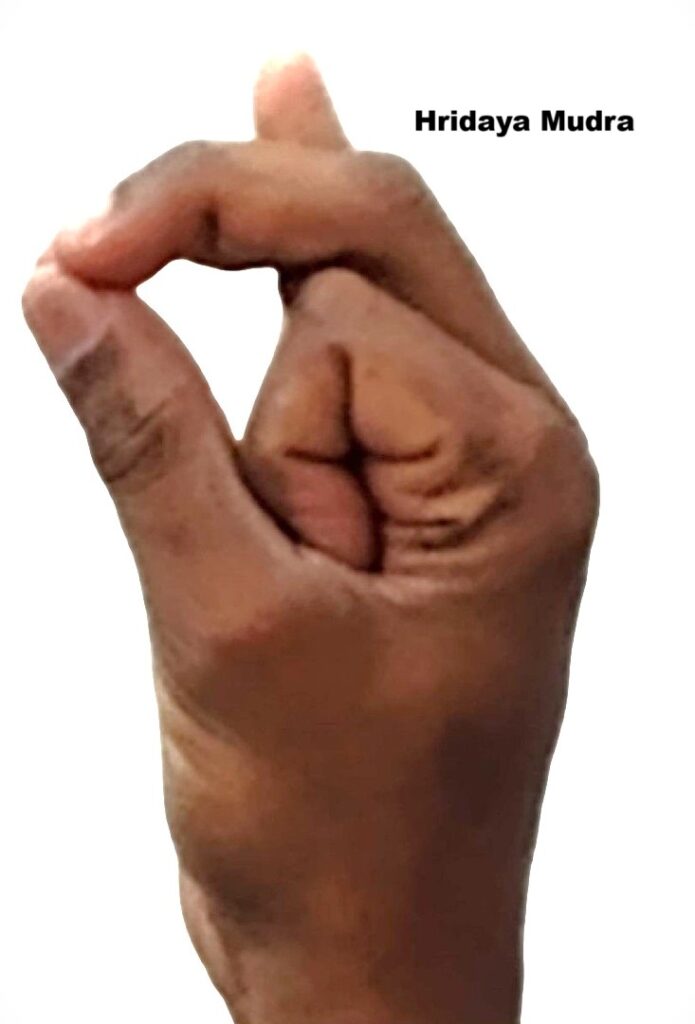Hridaya Mudra
Introduction
Hridaya Mudra is a yogic hand gesture aimed at supporting heart health and emotional balance. The Sanskrit word “Hridaya” means heart, symbolizing both the physical heart and the emotional/spiritual center. This mudra is used to cultivate emotional calm, compassion, and circulation of energy to the heart region, often practiced during meditation or pranayama.
Meaning
Hridaya (Heart): Represents love, compassion, and vitality.
Mudra (Gesture): A specific hand positioning that channels energy within the body.
Hridaya Mudra is believed to strengthen the heart, regulate blood pressure, and harmonize emotions by directing pranic energy toward the heart chakra (Anahata).
How to Perform (Method of Practice)
Step-by-Step:
Sit in a comfortable posture like Sukhasana (Easy Pose) or Padmasana (Lotus Pose) with a straight spine.
Using both hands, bend the index fingers until the tips touch their own bases. Then keep rolling the fingers down until
the first knuckles touch the base of each thumb.
Join the tips of the thumbs with the tips of their respective ring and middle fingers.
Allow the little fingers to remain extended, but keep them relaxed.
Hold as you sit quietly or meditate, or whenever you feel the need.
Close your eyes and breathe naturally, focusing on the heart center.
Practice Tip: Avoid forcing fingers; let the position be comfortable and stable.
Benefits
Physical Benefits:
Supports heart and circulatory health.
May help in lowering blood pressure.
Enhances oxygen flow and energy to the chest region.
Mental & Emotional Benefits:
Reduces stress, anxiety, and emotional turbulence.
Cultivates inner peace, compassion, and love.
Spiritual Benefits:
Activates and balances the Anahata (heart) chakra.
Promotes meditative focus and intuitive clarity.
Encourages emotional release and healing.
Contraindications
People with severe finger injuries or arthritis should avoid or modify the mudra.
Should not replace medical treatment for heart disease; use as a complementary practice.
Avoid overstraining fingers or wrist during the practice.
Anatomy & Physiology
Musculoskeletal: Engages small muscles of fingers and hand, enhancing dexterity.
Cardiovascular: Indirectly supports heart function by promoting parasympathetic activation.
Respiratory: Encourages deep, relaxed breathing, improving oxygenation.
Neurological: Stimulates sensory nerve endings in fingers, aiding mind-body connection.
Kinesiology
Fine motor coordination of phalanges and metacarpals.
Gentle stretching improves joint mobility of fingers and wrist.
Engages proprioceptive feedback loops enhancing hand awareness.
Neurology
Stimulates cortical areas related to focus, attention, and sensory perception.
Activates parasympathetic nervous system, promoting calm and emotional regulation.
Can positively influence heart rate variability (HRV) through relaxation response.
Duration of Practice
Beginners: 5–10 minutes per session.
Advanced: 15–20 minutes, once or twice daily.
Can be paired with Anulom Vilom or Bhramari Pranayama for enhanced benefits.
Counter Mudra
Gyan Mudra (index finger and thumb tip together) or Prithvi Mudra can be alternated to balance energy.
Switching to these mudras helps maintain overall mental clarity and grounding after heart-focused energy practices.
Conclusion
Hridaya Mudra is a simple yet profound practice that harmonizes body, mind, and heart energy. Regular practice can support emotional stability, heart health, and spiritual awareness. It is especially beneficial for stress management, cultivating compassion, and deepening meditation.
FAQ
Q1: Can Hridaya Mudra be practiced while lying down?
Yes, but sitting upright with a straight spine enhances energy flow.
Q2: How frequently should it be practiced?
Once or twice daily, ideally during meditation or calm periods.
Q3: Is it safe for children?
Yes, with supervision and shorter practice duration.
Q4: Can it replace medical heart treatments?
No, it complements but does not replace conventional medical care.
Q5: When will I feel the benefits?
Emotional calmness can be noticed within a few sessions; physical and spiritual benefits may develop over weeks of consistent practice.
References
Swami Satyananda Saraswati. Mudras for Healing and Transformation. Yoga Publications Trust.
Dr. Bharati Krishna Tirtha. Science of Mudras.
T.K.V. Desikachar. The Heart of Yoga: Developing a Personal Practice.
Yoga Journal articles on mudra therapy.
Clinical studies on hand gestures and heart rate variability.

